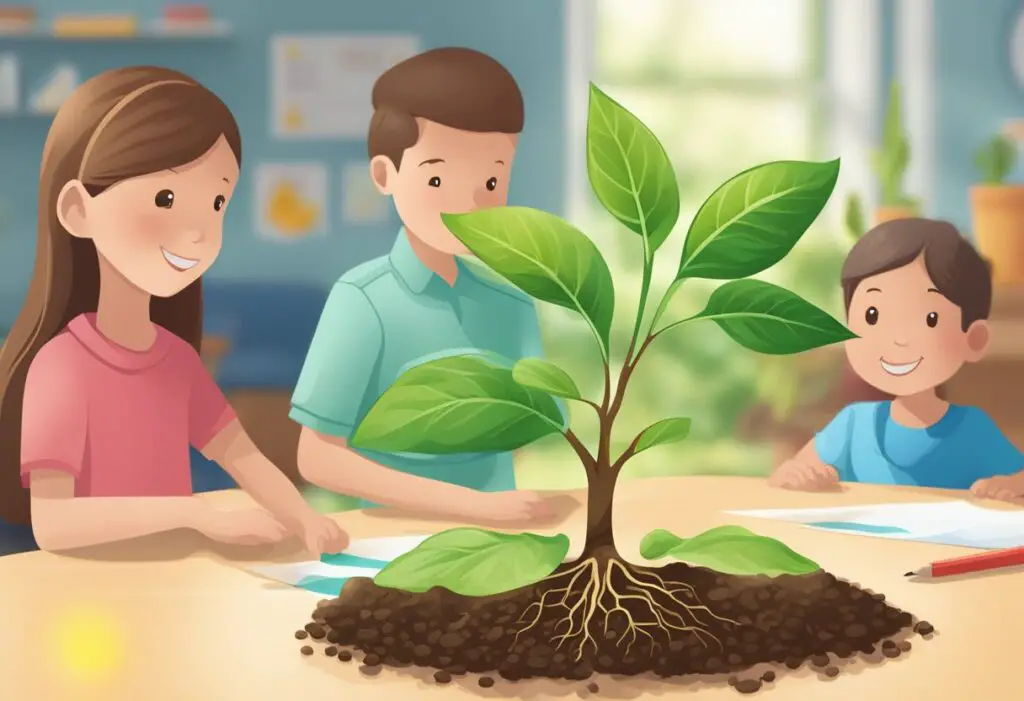So, you want to help your kindergartener develop a growth mindset?
Well, you’re in the right place! Developing a growth mindset is all about teaching your child to embrace challenges, persist through obstacles, and see failures as opportunities for growth.
It’s a powerful way of thinking that can set your child up for success in school and life.

But what exactly is a growth mindset? In a nutshell, it’s the belief that abilities and intelligence can be developed through hard work, dedication, and perseverance. This is in contrast to a fixed mindset, which sees abilities and intelligence as innate and unchangeable. The concept was popularized by psychologist Carol Dweck in her book “Mindset: The New Psychology of Success,” and has since been embraced by educators and parents alike. Stanford University also offers a free online course on the topic.
The Great Mindset Debate: Growth Vs Fixed
Are you ready for the great mindset debate? Let’s dive into the two mindsets that have been unveiled by psychologist Carol Dweck – growth and fixed.
The Two Mindsets Unveiled
So what’s the difference between the two? Well, if you have a growth mindset, you believe that your abilities and talents can be developed through hard work and dedication. On the other hand, if you have a fixed mindset, you believe that your intelligence and talent are fixed traits that cannot be changed.
Let’s break it down further. If you have a growth mindset, you embrace challenges as opportunities to learn and grow. You understand that failure is not a setback but rather a chance to improve and try again. You also believe that your effort and perseverance are the keys to success.
But if you have a fixed mindset, you may avoid challenges because you fear failure and believe that your abilities are limited. You may also give up easily when faced with obstacles because you believe that your intelligence and talent are fixed and cannot be improved.
-

Bold Male Pride – Baseball Trucker Cap Celebrating Masculinity
£18.00 Select options This product has multiple variants. The options may be chosen on the product page -

Dad Bod Appreciation Gift Mug
£14.00 Add to cart -

Dad Bod, Bad Jokes Structured Baseball Cap
£22.00 Select options This product has multiple variants. The options may be chosen on the product page
The Role of Intelligence and Talent
Now, let’s talk about the role of intelligence and talent. If you have a growth mindset, you understand that intelligence and talent are not fixed traits but rather qualities that can be developed over time. You believe that everyone has the potential to learn and grow, regardless of their initial abilities.
But if you have a fixed mindset, you may believe that intelligence and talent are innate qualities that cannot be changed. You may also judge yourself and others based on their initial abilities rather than their effort and progress.
So, which mindset is better? Well, research has shown that having a growth mindset can lead to greater success and happiness in life. By embracing challenges and believing in your ability to learn and grow, you can achieve your goals and reach your full potential.
In conclusion, developing a growth mindset is essential for success and happiness in life. By understanding the two mindsets and the role of intelligence and talent, you can cultivate a belief in your ability to learn, grow, and achieve your goals.
Nurturing a Growth Mindset in Kindergarten
Congratulations on taking the first step in helping your kindergartener develop a growth mindset! By nurturing a growth mindset, you can help your child learn, improve, and grow with effort and perseverance. Here are some tips for incorporating growth mindset activities and lessons into your child’s daily routine.
Growth Mindset Activities
There are many fun and engaging activities you can do with your kindergartener to help nurture a growth mindset. For example, you can try the “hard thing” rule, where your child chooses a difficult task and works on it until they master it. You can also encourage your child to embrace mistakes and learn from them by playing “the mistake game,” where you celebrate mistakes and brainstorm ways to learn from them.
Another great activity is “the power of yet,” where you teach your child to add the word “yet” to the end of their sentences. For example, instead of saying, “I can’t do it,” they can say, “I can’t do it yet.” This simple change in language can help your child develop a growth mindset and believe in their ability to learn and improve.
Incorporating Growth Mindset in Lessons
In addition to growth mindset activities, you can also incorporate growth mindset into your child’s lesson plans. For example, you can praise your child’s effort and hard work instead of just their grades or achievements. You can also encourage your child to ask questions and seek help when they need it instead of feeling ashamed or embarrassed.
Another way to incorporate a growth mindset is to teach your child positive self-talk. Help your child develop a list of positive affirmations they can say to themselves when they face challenges or setbacks. For example, “I’m capable of learning and improving” or “I can do hard things with effort and perseverance.”
The Power of ‘Yet’ and Positive Self-Talk
Remember, developing a growth mindset takes time and effort. Encourage your child to embrace challenges and mistakes as opportunities to learn and grow. Teach them the power of “yet” and positive self-talk, and praise their effort and hard work. With your help, your kindergartener can develop a growth mindset that will serve them well throughout their life.
Role of Parents and Teachers
As a parent or teacher, you play a crucial role in helping kindergarteners develop a growth mindset. Here are two important ways you can do this:
Language and Feedback
The way you talk to children can have a significant impact on their mindset. Encourage them to see challenges as opportunities to learn and grow. Use phrases like “I can see you’re working hard” or “I’m proud of you for trying something new.” Avoid praising intelligence or talent, as this can lead to a fixed mindset.
When giving feedback, focus on the effort rather than the outcome. For example, instead of saying, “Great job on getting an A,” say, “I can see you put a lot of effort into studying for that test.” This reinforces the idea that hard work and perseverance are important.
Modeling Growth Mindset
Children learn by watching and imitating the adults around them. Model a growth mindset by embracing challenges and showing perseverance. Talk about your own struggles and how you overcame them. Encourage children to take risks and try new things, even if they might fail.
When faced with a challenge, use phrases like “I’m going to keep trying” or “This is a good opportunity to learn.” This shows children that setbacks are a normal part of the learning process.
By using positive language and modeling a growth mindset, you can help kindergarteners develop the skills they need to become lifelong learners. Remember, it’s never too early to start fostering a growth mindset!
Challenges, Setbacks and the Road to Resilience
So, you’re trying to develop a growth mindset, eh? Well, buckle up, kiddo. It’s not always going to be smooth sailing. In fact, you’re going to face challenges and setbacks along the way. But don’t worry, that’s all part of the process.
Embracing Mistakes and Failure
First things first, let’s talk about mistakes and failures. Yes, you heard that right. We’re going to embrace them. Why? Because they’re a natural part of the learning process. Nobody’s perfect, and nobody gets everything right on the first try.
So, when you make a mistake or fail at something, don’t beat yourself up about it. Instead, take a deep breath, learn from your mistake, and try again. Remember, the only true failure is giving up.
Persistence and Grit: The Long Game
Now, let’s talk about persistence and grit. Developing a growth mindset is not a quick fix. It’s a lifelong journey that requires patience, determination, and grit.
When you face a challenge or setback, don’t give up. Keep pushing forward, even when it feels like you’re not making progress. Remember, every small step counts.
And when you feel like you’re about to give up, remind yourself of why you started in the first place. What are your goals? What motivates you? Keep your eye on the prize and keep pushing forward.
Wrapping Up
So, there you have it. Challenges and setbacks are a natural part of the journey to developing a growth mindset. Embrace your mistakes and failures, and keep pushing forward with persistence and grit. You’ve got this, kiddo!
Resources for the Growth Mindset Journey
Congratulations, you have decided to embark on a growth mindset journey with your kindergarten students! To help you on this journey, we have compiled a list of resources that will make your life easier.
Books and Videos
Books and videos are a great way to introduce growth mindset concepts to your students. Here are a few of our favorites:
-
The Dot by Peter H. Reynolds: This book and video teach children that it’s okay to make mistakes and that they can always try again.
-
Giraffes Can’t Dance by Giles Andreae: This book and video show children that it’s important to believe in yourself and that everyone has their own unique talents.
-
Sesame Street: Growth Mindset Playlist: This playlist includes a variety of videos that teach children about growth mindset concepts such as perseverance, resilience, and the power of “yet.”
Worksheets and Posters
Worksheets and posters are a great way to reinforce growth mindset concepts and provide your students with visual reminders. Here are a few resources that you can download and print:
-
Growth Mindset Posters by Teachers Pay Teachers: This set of posters includes 20 different growth mindset quotes that you can display in your classroom.
-
Growth Mindset Worksheets by Big Life Journal: These worksheets are designed to help children develop a growth mindset by teaching them about the power of positive thinking, perseverance, and more.
-
Growth Mindset Coloring Pages by Art is Basic: These coloring pages are a fun way to reinforce growth mindset concepts while also giving your students a chance to be creative.
So there you have it, some great resources to help you on your growth mindset journey with your kindergarten students. Download, print, and enjoy!







